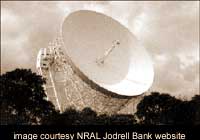Article/Document:
Alien Investigators: A Look at the SETI Institute
Space.com, 09 May 2000
original source | fair use notice
Summary: Based in Mountain View, California, the SETI institute is the most prominent organization involved in the search for intelligent life beyond Earth.
Seth Shostak is driving toward an observatory near the University of Berkeley in his beat-up Honda.
An eloquent, middle-aged man with a piercing voice, he is one of the few people on the planet who can call himself a full-time alien hunter. His license plate backs that fact up; it reads "SETI GUY." (SETI is the acronym for Search for Extraterrestrial Intelligence.)
Dr. Shostak is a scientist at the SETI Institute. Based in Mountain View, California, the SETI institute is the most prominent organization involved in the search for intelligent life beyond Earth.
Shostak is fiercely proud of the institute. "We're doing an experiment that's far and away the best SETI experiment that has ever been done," he said.
For many, the idea of "alien hunting" conjures up images of tabloid-reported UFO sightings and abductions. However, the SETI Institute has gained a reputation in the scientific community as a valid organization applying legitimate science, as it were, to the pressing question: Are we alone in the universe?
"They're real scientists," said Dr. Robert Park, a professor of physics at the University of Maryland and the director of the Washington office of the American Physical Society. "If you're looking for aliens in spaceships on Earth, you're out of your mind. But looking for radio signals is not so crazy."
The institute has also benefited from recent findings that planets are not as rare in the universe as once thought. That puts the SETI Institute in a prime position as the leader in the search for extraterrestrials.
"It's basically the mother church," said John Pike, director of space policy at the Washington, D.C.-based Federation of American Scientists. "Either you think that SETI is a worthwhile undertaking, in which case they're doing the Lord's work, or you think it's a complete waste of time. I think they're laboring in the right vineyard."
To be sure, many believe that the institute's work -- some of which involves using radio telescopes to search for alien signals being sent to Earth, either intentionally or inadvertently -- is out of touch with reality. Recent books have declared extraterrestrial intelligence to be extremely rare.
In Rare Earth: Why Complex Life Is Uncommon In the Universe, geologist Peter D. Ward and astronomer Donald Brownlee write that the universe has many dead zones in which life is highly unlikely to exist. They also insist that inhabitable planets are "extremely rare."
But while the search for aliens occupies the lives of SETI Institute scientists, the institute makes no claims to knowing if there is, in fact, anyone out there.
"The answer is there is either life and intelligent life elsewhere, or there isn't," said Dr. Jill Tartar, the director of the Institute's Project Phoenix, a broad search for alien signals that uses some of the world's largest telescopes. "Science is capable of asking the question and trying to do the experiments to find the answer."
The SETI institute was founded in 1984 as a nonprofit corporation, and in 1985 NASA awarded the institute a contract to play a major role in a search being performed by the space agency.
However, in 1994 a budget-conscious Congress cut funding for the NASA SETI program. The SETI Institute, which had become reliant on public funds, was suddenly in crisis.
"It happened on a Friday, and I came home and told my husband not to leave me alone with any sharp objects," said Dr. Tarter. "It was really pretty devastating."
From that point on the institute was forced to rely on private donors and has attracted millions of dollars in donations. Its endowment currently stands at $25 million.
But the lack of public funding has forced the institute to take on cheaper, but experimental, methods to continue its search.
In April, the institute unveiled the prototype for an array of satellite dishes that might be able to be combined to form a radio telescope that could become the world's most powerful.
The method, still unproven, is to link up hundreds or thousands of inexpensive off-the-shelf satellite dishes. Traditionally, radio telescopes have been gigantic structures that have extraordinarily expensive construction costs.
Is SETI doing a service for society? By conducting relatively inexpensive searches without the use of public funds, the SETI Institute, in the worst case, is only wasting its own time and money. But to those who believe that Earth is not the only planet with intelligent life, the institute's work is unquestionably worthwhile.
"I think most people think there are aliens out there," said Dr. Park. "With the limitations in space and time I don't think we'll ever see any of them. But communicating with them is another matter. It's awfully expensive and difficult to try to send a human being through space, but sending radio signals, that's cheap."
Read more articles on this topic:






